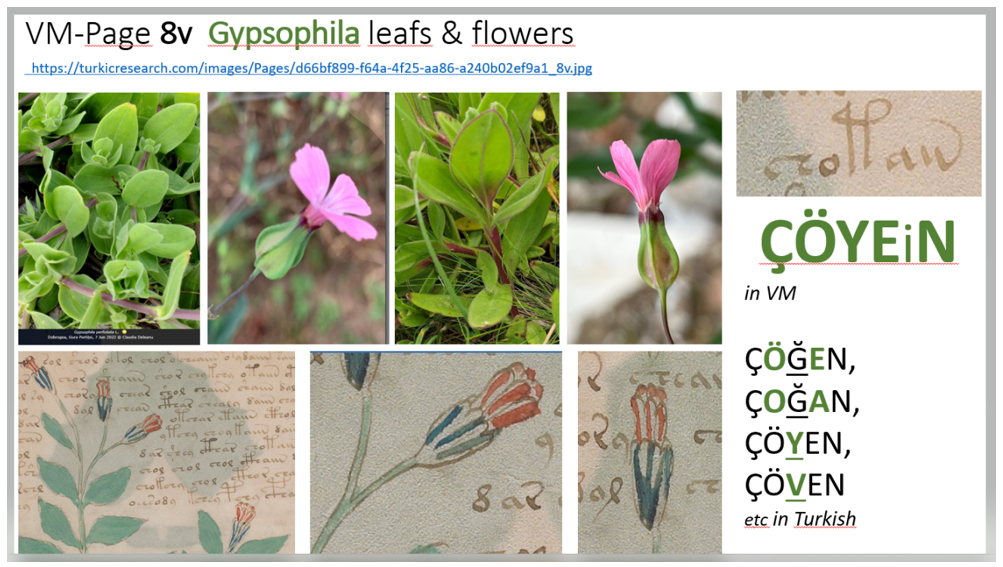ÇÖYEN (çoğan/çöven/çöğen)

ÇÖYEN (çoğan/çöven/çöğen)
Original-Latin : ÇÖYEiN
Transcript :
While making the following explanations here, as always, we first read a word by adhering to our ATA-aflabe transcription table. We show this word as it was written approximately 600 years ago, and we also give its spelling in modern Turkish and different dialects. Thus, anyone who understands linguistics will be able to see the phonetic closeness. Moreover, as always, we find and show the spelling of these words in various dictionaries, including historical dictionaries. Thus, the number of words overlapping with the drawings, being on the same pages, was 110.
This word is mentioned in the source MS-work called [İbni Mühenna, Lugat], which is a dictionary manuscript written before 1310 (used in before and after the Ottoman Empire time ).
Source dictionary:
https://www.nisanyansozluk.com/kelime/%C3%A7%C3%B6ven
The author wrote this plant as "ÇÖYEiN" about 600 years ago. In terms of phonetic value change, only the letter "i" seems to have decreased in about 600 years. At the same time, it can be said that the letter "Y" has turned into "Ğ" and "V" sounds today. However, the "Y" and "Ğ" forms are still found (in the dialects of the Azerbaijani region). This is a very small/insignificant change in phonetic/sound-value in the intervening 600 years. Moreover, this sound change is widely described/very-familiar by linguists. The Latin genus name of this plant is known as Gypsophila. The Modern-Turkish word "çöven" is also called "çöğen" in some dialects. In Azeri-Turkish and Turkmen, it appears as "çoğan" ("ÇÖYEN-OTU" in some dialects). It is in the form of "ÇOĞAN" in Old Kipchak-Turkish. It is also mentioned as "çoğan" (چغان) in the Ottoman "Tarama Dictionary". In Anatolian dialects (in modern times), the forms "cöğen", "cöven" and "çuvan" are often used. It is also seen as "Çevgen" in some sources.
This Çöven/Çöyen is a medicinal plant that comes from the clove family and grows widely in Turkey. We can say that this plant, which is 50-120 cm tall, has pink /white flowers. In some sources, nearly 90 species are mentioned. The leaf and flower structure of this plant varies between some of this family species.
These plant genera exist in a diversity of 59 taxon (59 taxon/taxonome) in today's geography of Turkey, but a greater variety of species can also be seen as endemic in various places throughout Europe and Asia.
See ÇÖVEN in wikipedia:
https://tr.wikipedia.org/wiki/%C3%87%C3%B6ven#:~:text=G%C4%B1da%20sanayiinde%20a%C4%9Fday%C4%B1%20a%C4%9Fart%C4%B1c%C4%B1%20%C3%B6zelli%C4%9Finden,sanayiinde%20de%20geni%C5%9F%20%C3%A7apta%20kullan%C4%B1l%C4%B1r.
You can look at the following dictionary pages as resources:
ÇOĞAN/ÇÖYEN (page 94, 186, 188 in this source)> "Historical-dictionary-of-ottoman-turkish-terms-for-gardens-and-gardening" (Dumbarton Oaks, Trustees for Harvard University.) > https://doczz.biz.tr/doc/12366/historical-dictionary-of-ottoman-turkish-terms-for
&
ÇÖVEN > https://sozce.com/nedir/80204-coven
&
ÇÖĞEN > https://sozce.com/nedir/79474-cogen
&
ÇOGAN > https://sozce.com/nedir/78274-cogan
Page from which we quote this leaf image 1:
Gypsophila perfoliata L.VU
Dobrogea, Gura Portiței, By Claudia Deleanu
https://spontana.org/species.php?id=1755
Page from which we quote this leaf image 2:
By Creator Богданович Светлана > Publisher iNaturalist
> Record licence http://creativeco...censes/by-nc/4.0/
> References https://www.inatu.../photos/280981554
> Identifier https://inaturali...1554/original.jpg
https://www.gbif.org/tools/zoom/simple.html?src=//api.gbif.org/v1/image/cache/occurrence/4121005382/media/985316994d19e47e3b15e1d54eda059e
This Gypsophila flower photo-1 By Jeff Forman: https://www.inaturalist.org/taxa/72156-Gypsophila
This Gypsophila flower photo-2 By Jianstargazer:
https://www.inaturalist.org/taxa/72156-Gypsophila/browse_photos
Note: We have very limited information about the properties of the plant. In Anatolia, this plant is used in the production of foods such as halva and ice cream. It is known that it is also used in the preparation of medicine in the medical field. It is written in some sources that this plant is mostly used in the composition of a kind of diuretic drug. For more about this plant, It is necessary to consult botanists to get more precise information about the total number and characteristics of all Gypsophila/ÇÖYEN species.
See:
https://dergipark.org.tr/tr/download/article-file/946559
-------------------
Bu bitkiyi yazar yaklaşık 600 yıl önce "ÇÖYEiN" biçiminde yazmış. Fonetik değer değişimi açısından yaklaşık 600 yıl içerisinde sadece "i" harfi düşmüş görünüyor. Aynı zamanda "Y" harfi günümüzde daha çok "Ğ" ve "V" sesine dönüşmüştür denilebilir. Fakat halen "Y" ve "Ğ" biçimine (Azerbaycan böygesi ağızlarında) raslanmaktadır. Bu aradan geçen 600 yılda oldukça küçük/önemsiz bir ses değeri değişimidir. Üstelik bu ses değişimi dil bilimciler tarafından yaygın şekilde tanımlanmıştır/çok-bilindiktir. Bu bitkinin Latince cins adı Gypsophila olarak bilinmektedir. Modern-Türkçe "çöven" kelimesini bazı lehçelerde "çöğen" olarak da adlandırılar. Azeri-Türkçesinde ve Türkmencede "çoğan" (bazı ağızlarda "ÇÖYEN-OTU") biçiminde geçer. Eski Kıpçak-Türkçesinde "çoğan" biçimindedir. Osmanlıca Tarama Sözlüğü'nde yine "çoğan" (چغان) olarak geçer. Anadolu ağızlarında (modern zamanda günümüzde) çoğunlukla "cöğen", "cöven", "çuvan" biçimleri de geçer. Kimi kaynaklarda "çevgen" olarak da görülür.
"Çöven/Çöyen-otu", karanfilgiller familyasından gelen, Türkiye'de yaygın olarak yetişen bir şifalı bitki. Boyu 50-120 cm olan bu bitki görüldüğü kadarıyla pembe-beyaz çiçeklere sahiptir diyebiliriz. Bazı kaynaklarda 90'a yakın türünden bahsedilir. Bu bitkinin yaprak ve çiçek yapısı bazı türler arasında farklılık göstermektedir.
